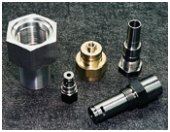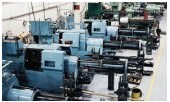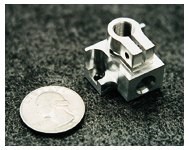Winning A Place For The First CMM
Automated inspection plays a key role in this historically non-CNC shop, thanks in large part to the shop's system for efficient CMM setup.
Share




When a shop moves from manual gaging to a CMM, whether or not a part meets spec is no longer determined by the skilled "feel" of an experienced machinist. In a way, quality is out of the machinist's hands.
Nevertheless, manual inspection does have limitations. Some shops find they are spending too much of their productive time on gaging. Others find themselves confronted with parts too complex to make manual inspection practical. And still other shops, like Roberts Automatic Products (Chanhassen, Minnesota), meet both of these challenges simultaneously.
Roberts Automatic—as the name implies—is a company built on automatic screw machine work. Many of its most senior and valued employees aren't programmers, they're machinists—with a practiced ability to look at a customer's print, and set up a multispindle lathe to produce the corresponding part by the thousands. To these men, hand-held gages have always been the tools used to pass final judgment on whether the machine has been set up correctly.
However, Roberts found itself facing shrinking batch sizes that made it crucial to perform this setup inspection faster. At the same time, inspection of production parts was growing more difficult throughout the shop, as the company's growing CNC area brought in more and more complex jobs. Both trends meant that automated inspection, along with the departure from long-standing shop practice, would soon become a necessity. Roberts responded by buying a programmable, PC-controlled CMM from Mitutoyo (MTI Corporation, Aurora, Illinois).
Vice president of engineering Ron Olberg was one of the employees key to making CMM inspection an integral part of Roberts' process. The starting point for this transition was a separate quality area for the CMM, with only a small number of technicians trained to operate the machine. However, Mr. Olberg and Roberts both came to envision CMM inspection moving beyond this limited role, to become accessible to the shop floor. Now, two years after the first CMM was purchased, automated inspection is a trusted part of every major job at Roberts, and a plan to purchase a second CMM for shop employees is moving forward.
Mr. Olberg doesn't know precisely when this trust was won. Nor does he have any advice for winning the confidence of machinists in other shops. What he does know is how to use a CMM efficiently. And the system he devised to simplify automated inspection likely helped the CMM to become accepted.
The system establishes a simple platform for changeover from one part's inspection setup to another—a process which may otherwise be the most complex aspect of CMM inspection. A classic job shop, Roberts machines—and inspects—a diverse and ever-expanding mix of parts. However, thanks to the combination of tools and strategies Roberts now applies to CMM changeover, inspecting any series of very different parts is almost as simple as inspecting the same part over and over. Results include faster quality confirmation for the customer or the shop floor, and less likelihood of human error.
But one more result is that the CMM inspection process is immediately understandable, even to a machinist unfamiliar with CNC. Roberts' system makes a CMM less of an arcane device. Instead, it's more like an appliance, one which might be—and soon will be—used by anyone in the shop.
The Case For A CMM
Roberts' decision to buy the CMM had much to do with shrinking lot sizes. With customers ordering their parts in smaller batches, Roberts found itself changing over its automatic machines more frequently than ever before.
Company president Ted Roberts describes it this way: "We used to run the machine for three months straight to produce a year's worth of parts. Now, we run for three weeks to produce a quarter's worth, and stop there." In other words, the time spent on setup quadruples, while the number of parts delivered in a year stays the same.
Mr. Roberts answered this trend with an employee "setup reduction team." One of the team's observations was that much of the changeover delay could be credited to first-article inspection, where the machinist submits a part for independent confirmation that his setup is indeed producing the part to spec. This inspection generally took hours to perform with manual gages, and often left a machine sitting idle for an entire shift while the machinist awaited results. If an automated CMM could eliminate just half of this delay, then—at screw machine productivity—the savings from every job would free up capacity equivalent to thousands of additional parts.
But faster setup wasn't the only reason to automate inspection. Roberts also inspects finished production parts, according to its customers' various quality assurance needs. And while screw machine setup parts were being inspected more frequently, finished parts throughout the company were taking more time to inspect, because jobs were growing more complex. Roberts' desire to make CNC machining a bigger part of its business continues to attract more jobs that require not just screw machine work, but also critical CNC machining. And when the long sequence of machining operations is finished on some of these jobs, the parts can be impossible to inspect by hand economically.
The trend came to a decision point with the arrival of the nozzle block part (shown at left). This tiny part has not only 150 critical dimensions, but also several holes that must locate with respect to perpendicular holes—a requirement that could only be confirmed manually through a long series of several measurements. Roberts' quality technicians were able to inspect nozzle blocks by hand, but the job took over eight hours just for one piece. That's why this part made the decision final; it was time to buy a CMM.
Now, Roberts inspects nozzle blocks in batches of four, in a CMM cycle that takes 35 minutes total. Most of Roberts' parts take even less time to inspect. The efficiency has made quality assurance almost a negligible factor in overall production time, and has allowed one employee to handle all of the shop's measurement needs where once the job required two. And applying the same efficiency to first-article inspection gives the machinist almost instantaneous confirmation of the accuracy of the setup, minimizing the downtime before the job can run.
However, these are just the immediate benefits. Ted Roberts says there are still other, less tangible benefits that flow from a CMM's consistency and reliability. Many customers are more confident in the service Roberts delivers. Where customers require a capability study before awarding a contract to the shop, or a record of in-process inspection data for a job currently being run, Roberts now has more than manual measurements to offer. Instead, the shop uses the CMM and its PC to generate—and analyze—detailed, repeatable and objective inspection data.
Programming Time
None of these benefits came overnight. Programming the CMM for a new part takes just about as much time as inspecting the same part by hand, says Ron Olberg. That's why the CMM can save time only when the program is already written. Mr. Olberg spent much of the first year with the CMM on writing programs for the shop's recurring jobs. Now, there are 200 programs on file, with programs for new jobs being added at the rate of about one per week.
Mr. Olberg advises other shops looking for a PC-controlled CMM to investigate the system's compatibility with the shop's—or customers'—preferred CAD/CAM system. For Roberts, this compatibility will make programming some jobs easier. Since purchasing the CMM, the shop has seen a surge in its use of CAD/CAM for CNC programming. Now, the company is investigating the use of CMM software from the same vendor as the CAD/CAM software, to let Roberts use the same geometry data to automate CMM programming. At the time the CMM was purchased, however, the shop didn't foresee how useful it would be for the inspection technology to share a common platform with other engineering functions.
Even so, the manual programming approach continues to work quite well. With a little foresight and planning—and provided there is a prototype or trial version of the part available to use as a guide—Mr. Olberg can generally write a program and get it into the system before there are parts that need to be measured. He applies exactly this sort of planning to screw machine jobs, for which there is rarely any electronic data available anyway. While the machinist sets up one of these jobs and runs trial parts to test how close he is to spec, Mr. Olberg grabs a rejected trial part and goes to work on the program. He doesn't need perfect geometry for this work, just a part close enough to the finished form that he can use it to map out CMM touches. By working with a part that's a near-miss, he can have the program ready for first-article inspection by the time the machinist brings him a part that he believes has been cut to spec.
Mr. Olberg may continue to be the primary CMM programmer for some time. However, he foresaw that operation of the CMM should one day be open to many others—so, for example, a machinist might perform his own first-article inspection. To realize this goal, Mr. Olberg engineered the system around the CMM to make inspection of recurring parts as easy to perform as possible. Key to this process is a universal fixture that lets anyone perform an accurate setup quickly, and allows a star-shaped probe and its styli to remain in the CMM essentially full time.
How To Streamline Inspection
"What I wanted was a system where no one would have to touch the probe," Mr. Olberg says. Though changing the CMM probe is not difficult, in relative terms it is one of the more complex aspects of CMM inspection. For example, any change to the probe, including a stylus change, calls for recalibration. If Roberts established a CMM process that involved manually changing the probe or its styli from time to time, then CMM access would have to be limited only to employees who were proficient in this operation. Mr. Olberg preferred a more open approach.
This left him with two options: Either leave just one probe in place, or purchase an automatic probe changer. He chose the former option not only to save money, but also to keep the process as simple as possible.
Why a star-shaped probe? The virtue of this configuration (as shown in the photo at the beginning of this article) is that it can indeed perform just about all of a typical shop's inspection work. This type of probe features five styli—a vertical one pointing down, and four horizontal ones arrayed like the points of a compass. While the down-pointing stylus can reach any exposed surface, the horizontal styli can touch features recessed into any vertical faces of the part. To complement the versatility of this arrangement, Mr. Olberg adds styli with a relatively small ball diameter—1 millimeter—to enable the probe to reach into tight crevices. As a result, it's a rare part for Roberts that can't be inspected using this one probe.
However, implementing this system is not as simple as just choosing the right probe and leaving it alone. There is a reason why CMM users change probes: Different probes present different problems with access. The star-shaped probe, for example, has the vertical stylus always sticking down, even when one of the horizontal styli are making the touch. For this reason, the only way to provide clearance for this vertical stylus is to suspend some parts off the table. So Mr. Olberg custom-engineered a solution to accomplish exactly that. The same solution ensures that setup time will have a negligible impact on the overall inspection time.
Mr. Olberg devised a universal fixture that now remains in place on the CMM table (see photo, above left). The fixture offers twelve posts for supporting workpieces above the table's level. Each of these posts (see photo, above right) has a magnet embedded in the end to hold the part in place. When the workpiece is nonferrous, a piece of double-sided tape can do the same job, because the goal is simply to position the part approximately where the program expects to find it. By the same token, metal spacers are sufficient to establish the part's horizontal position repeatably atop the surface.
This means the operator doesn't have to take time to have the CMM touch off a part to locate it prior to the inspection run. Nor does he even have to know how to make these touches. Instead, the CMM program is written with an approximate location for the part already assumed. The operator has only to lay down spacers appropriate to that part. Along with a standard supply of these spacers, the CMM fixture isn't just a workholding tool, but also the basis for a system of efficient CMM changeover.
Mr. Olberg now adds a few extra lines of notation to every program he writes. This text gives the operator clear instructions as to which spacers the program requires, and how to apply them to configure the workpiece properly. As a result, setting up a part—whether Mr. Olberg does it, or someone else—consists of just reading the instructions, putting the indicated spacers in place, and butting the part against these. Thus, the fixture not only avoids the complication of a stylus change, it also virtually eliminates any setup delay.
The Next Step
And in its way, the fixture also helped the CMM win the acceptance of the employees on the shop floor. It reduced CMM inspection to an even more straightforward process than it would have been otherwise.
What did it take to convince Roberts' long-time machinists that the CMM could be trusted? Mr. Olberg suspects the main ingredient was just time.
"Our people were skeptical, and with good reason. But that doesn't mean they couldn't be persuaded," he says.
"No one cares to have a PC tell him that the part he thought was accurate is actually out of spec. However, on the occasions when that did happen, the machinist almost always returned to his own gages and concluded the CMM might just be right. After that happens a few times, and after you see that the CMM will detect the same error in a long series of parts from the same machine, you start to realize that the device really can show us what needs fixing in our process."
Now that the CMM in Roberts' quality area has proven its effectiveness, the next step will be to apply what the shop has learned to a second CMM—one accessible to the machinists on the shop floor.
Mr. Olberg says the reaction to this prospect shows how much the attitude toward automated inspection has changed. "With the first CMM, the question was 'Can we really believe this thing?' Now, machinists ask, 'When are we getting our own?'"
Related Content
The Link Between CNC Process Control and Powertrain Warranties
Ever since inventing the touch-trigger probe in 1972, Sir David McMurtry and his company Renishaw have been focused on achieving process control over its own manufacturing operations. That journey has had sweeping consequences for manufacturing at large.
Read MoreHow to Evaluate Measurement Uncertainty
Manufacturing and measurement are closely coupled. An important consideration for the use of measurement results is the associated measurement uncertainty. This article describes common metrology terms and provides an example uncertainty analysis.
Read MoreBallbar Testing Benefits Low-Volume Manufacturing
Thanks to ballbar testing with a Renishaw QC20-W, the Autodesk Technology Centers now have more confidence in their machine tools.
Read MoreHelp Operators Understand Sizing Adjustments
Even when CNCs are equipped with automatic post-process gaging systems, there are always a few important adjustments that must be done manually. Don’t take operators understanding these adjustments for granted.
Read MoreRead Next
Setting Up the Building Blocks for a Digital Factory
Woodward Inc. spent over a year developing an API to connect machines to its digital factory. Caron Engineering’s MiConnect has cut most of this process while also granting the shop greater access to machine information.
Read MoreRegistration Now Open for the Precision Machining Technology Show (PMTS) 2025
The precision machining industry’s premier event returns to Cleveland, OH, April 1-3.
Read MoreBuilding Out a Foundation for Student Machinists
Autodesk and Haas have teamed up to produce an introductory course for students that covers the basics of CAD, CAM and CNC while providing them with a portfolio part.
Read More

















.jpg;width=860)





















